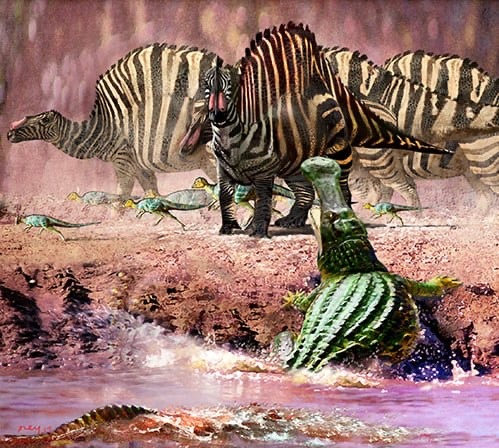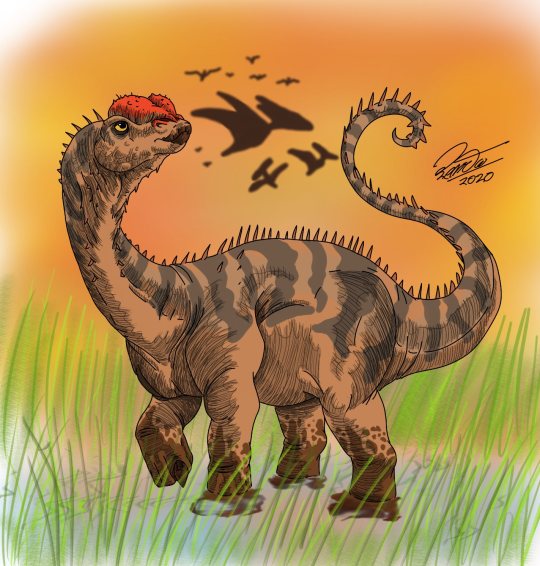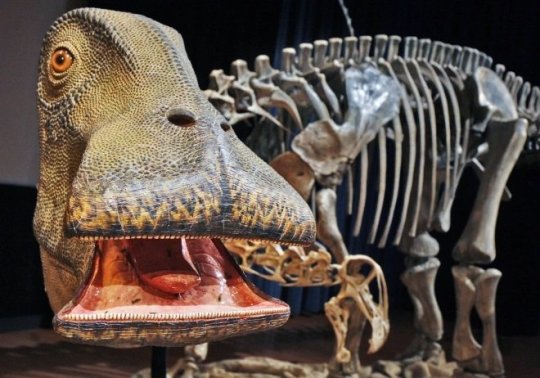#elrhaz
Explore tagged Tumblr posts
Photo

Kryptops Dinosaur Tooth Fossil Grade A Abelisaurid Elrhaz Formation Cretaceous Niger
This is a top-grade, authentic Kryptops dinosaur tooth fossil from the Early Cretaceous period, expertly sourced from the Elrhaz Formation in Gadaoufa, Tenere Desert, Niger. This carefully selected specimen represents a rare carnivorous theropod dinosaur in the Abelisaurid family, offering a fascinating insight into prehistoric African ecosystems.
The exact fossil shown in the listing is the one you will receive. A 1cm scale cube is included in the photo for reference. This fossil has been chosen for its preservation, scientific value, and presentation quality.
Scientific & Geological Information:
Genus: Kryptops (formally identified and described by Sereno & Brusatte, 2008)
Family: Abelisauridae
Superfamily: Abelisauroidea
Order: Theropoda
Geological Stage: Aptian Stage, Early Cretaceous (~113 million years ago)
Formation: Elrhaz Formation
Zone: No formally defined zone for Elrhaz; part of Aptian terrestrial deposits
Depositional Environment: Fluvial – rivers, floodplains, and deltaic systems
Morphology Features: Recurved, laterally compressed tooth with fine serrations; robust enamel and wear indicative of predatory feeding habits
Notable: One of the earliest Abelisaurid theropods; known from the same fauna as Suchomimus and Nigersaurus; fossils from this region are exceptionally rare and scientifically significant
Why Choose This Fossil?
100% genuine specimen with legal provenance
Includes Certificate of Authenticity
Carefully selected Grade A specimen with excellent morphology
Rare opportunity to own a tooth from one of Africa’s early predatory dinosaurs
Ideal for collectors, educators, and fossil enthusiasts
Shipping & Handling:
Professionally packed for safe delivery
Ships worldwide with tracking
Add this rare and historic Kryptops dinosaur tooth to your collection today.
All of our Fossils are 100% Genuine Specimens & come with a Certificate of Authenticity.
#Kryptops dinosaur tooth fossil#Abelisaurid theropod tooth#Elrhaz Formation fossil#Cretaceous dinosaur tooth#dinosaur fossil from Niger#Tenere Desert fossil tooth#African dinosaur fossil#authentic Kryptops tooth#rare carnivorous dinosaur fossil#Abelisauridae tooth#certified dinosaur fossil#theropod fossil specimen#fossil for collectors#predator dinosaur tooth
1 note
·
View note
Text

A Cretaceous lungfish tooth plate of a Neoceratodus africanus or Ceratodus sp. from the Elrhaz Formation in Gadoufaoua, Niger. These giant Mesozoic lungfish would have been prey for genera like Suchomimus tenerensis and Sarcosuchus imperator.
#fish#lungfish#dipnoi#fossils#paleontology#palaeontology#paleo#palaeo#neoceratodus#ceratodus#ceratodontidae#neoceratodontidae#cretaceous#mesozoic#prehistoric#science#paleoblr#ネオケラトドゥス#ケラトドゥス#ネオセラトーダス#セラトーダス#ハイギョ#化石#古生物学#ケラトドゥス科
134 notes
·
View notes
Text

Suchomimus, meaning "crocodile mimic," was a spinosaurid dinosaur that lived during the Early Cretaceous period, approximately 125 to 112 million years ago. Its name reflects its crocodile-like skull, which was long and shallow, ideal for catching fish. Discovered in Niger, Africa, by paleontologist Paul Sereno and his team in 1997, the dinosaur's remains were found in the Elrhaz Formation, a region known for its rich fossil deposits. Suchomimus was a large theropod, measuring between 9.5 and 11 meters (31–36 feet) in length and weighing up to 3.8 metric tons. Its forelimbs were robust, equipped with giant claws, and it had a low dorsal sail along its back formed by elongated neural spines.
This dinosaur's diet primarily consisted of fish, supported by its specialized teeth and jaw structure. It likely inhabited fluvial environments, such as floodplains, alongside other dinosaurs, pterosaurs, and aquatic creatures like bony fishes and turtles. Some paleontologists suggest that Suchomimus might be an African species of the European spinosaurid Baryonyx, or even a junior synonym of Cristatusaurus lapparenti, though these classifications remain debated. Its discovery has provided valuable insights into the diversity and adaptations of spinosaurid dinosaurs.
Suchomimus' anatomy suggests it was well-suited for a semi-aquatic lifestyle, wading in shallow waters to hunt prey. Its powerful arms and claws may have been used to catch fish or other small animals. The discovery of Suchomimus has highlighted the evolutionary link between dinosaurs and modern reptiles, showcasing how certain species adapted to specific ecological niches. This fascinating creature continues to be a subject of study, shedding light on the complex ecosystems of the Early Cretaceous.
#art#drawing#illustration#sketch#artwork#artist#dino#dinosaur#dinosaurs#prehistoric#extinct#paleoart#paleontology#theropod#spinosaurid#suchomimus#baryonyx#reptile
23 notes
·
View notes
Text
Suchomimus at a watering hole hunting as the sun sets. She caught that fish, hooray!

Been messing around with lighting and stuff lately and since I’ve been working on models from the elrhaz formation, thought I’d show them off. Still got more creatures to make, tho. Kryptops, sarcosuchus, eocharcaria, maybe nigersaurus or ouranosaurus too
20 notes
·
View notes
Text

#Archovember Day 24 - Araripesuchus wegeneri
The notosuchians were were such a diverse group of pseudosuchians you’d think they came from the Triassic. But no, this group of “mammal-mimicking” crocodylomorphs lived during the Jurassic and Cretaceous. One such Cretaceous notosuchian was Araripesuchus. This genus was widespread across the Southern Hemisphere, represented by at least 6 different species, mostly identified by their unique teeth. Today’s species is Araripesuchus wegeneri, the “Dog Croc.”

Living in Early Cretaceous Niger, Araripesuchus wegeneri appeared to be an omnivore, eating both plants and insects like grubs. Its common name “Dog Croc” is a reference to not only the dog-like shape of its skull, but also its unique caniniform teeth. Araripesuchus wegeneri fossils were found in a block with five skeletons packed together, so they may have even been social. All species of Araripesuchus had large eyes and thin osteoderms covering their body. They were likely more agile on land than in water, due to their long limbs. It could have possibly used its long legs to sprint to the water in order to flee predators, then used its muscular tail to swim.
There was a significant amount of pseudosuchian diversity in the Elrhaz Formation. Araripesuchus wegeneri would have lived alongside the similarly sized, duck-billed notosuchian Anatosuchus. It would have had to look out for the giant “Super Croc”, Sarcosuchus (perhaps the reason it had adapted for leaving the water so easily!) It would have also lived alongside the long-snouted fish-eater Stolokrosuchus. There were dinosaurs here as well, such as the iguanodont Lurdusaurus, the hadrosaur Ouranosaurus, the carcharodontosaurid Eocarcharia, the abelisaurid Kryptops, the spinosaurid Suchomimus, and the duck-billed sauropod Nigersaurus.
#my art#SaritaDrawsPalaeo#Araripesuchus wegeneri#Araripesuchus#notosuchians#pseudosuchians#archosaurs#archosauromorphs#reptiles#Archovember#archovember2023
12 notes
·
View notes
Video
youtube
The remains of Suchomimus were found in the Elrhaz Formation in Niger,
0 notes
Text

Nigersaurus merupakan sebuah genus dinosaurus sauropoda dari famili Rebbachisauridae yang hidup pada pertengahan periode Kapur, sekitar 115 sampai 105 juta tahun yang lalu. Fosilnya ditemukan di Formasi Elrhaz, yang terletak di daerah Gadoufaoua, di Niger. Salah satu spesiesnya yang telah diketahui pernah hidup pada zaman kapur awal, sekitar 110 juta tahun yang lalu dan memiliki habitat di hutan wilayah Afrika Utara.[1] Dinosaurus ini dijuluki sebagai "mesin pemotong rumput mesozoikum" karena bentuk persegi pada mulut atau moncong yang dimilikinya.[2] Nama Nigersaurus diambil dari bahasa Yunani yang berarti "kadal Niger", dan nama spesifiknya menghormati paleontolog Phillipe Taquet, yang menemukan sisa-sisa fosil pertamanya.
0 notes
Text
yes, I know I'm only listing a few things per ecosystem, these polls have character limits
polls can only have ten options. I did my best. I even made a sacrifice - my favorite dinosaur, Maiasaura, is from Two Medicine, which I did not include, because its very similar to Hell Creek. So.
446 notes
·
View notes
Text
In a scene very reminiscent of East Africa's Mara River today, a herd of Ouranosaurus steers clear of Sarcosuchus while looking for a place to cross. (The little ornithopods running past are indeterminate and ornamental, according to Luis.)
Ouranosaurus nigeriensis
('brave/courageous reptile from Niger')
Styracosterna Hadrosauriformes
Elrhaz Formation, Ténéré Desert, Agadez, Niger.
Lower Cretaceous, ~112 Ma.
~
Artwork by Luis V. Rey.

Daily Dino Fact #13
20 notes
·
View notes
Photo

Is a genus of herbivorous basal hadrosauriform dinosaur that lived during the Aptian stage of the Early Cretaceous of modern-day Niger and Cameroon. Ouranosaurus measured about 7 to 8.3 metres (23 to 27 ft) long. Two rather complete fossils were found in the Elrhaz Formation, Gadoufaoua deposits, Agadez, Niger, in 1965 and 1970, with a third indeterminate specimen known from the Koum Formation of Cameroon. The animal was named in 1976 by French paleontologist Philippe Taquet; the type species being Ouranosaurus nigeriensis. The name is a combination of the Arabic word for "courage" and the country of discovery, although ourane is also the Tuareg name for the desert monitor.
Herbivore
Ouranosaurus (c) Jurassic World Camp Cretaceous Art (c) reneg661
6 notes
·
View notes
Photo

Spinosaurus Dinosaur Tooth Fossil – Genuine Specimen – Suchomimus Cretaceous CERTIFICATED
All of our Fossils are 100% Genuine Specimens & come with a Certificate of Authenticity
**Please note: Some fossils maybe propped up for photo purposes**
Dinosaur: Spinosaurus (Suchomimus )
Specimen: Tooth
Age: Elrhaz Formation, Cretaceous
Location: Gadaoufa region of the Tenere Desert, Niger
Scale cube=1cm:Full sizing please see photo.
Spinosaurus, genus of theropod dinosaurs belonging to the family Spinosauridae, known from incomplete North African fossils that date to Cenomanian times (roughly 100 to 94 million years ago). Spinosaurus, or “spined reptile,” was named for its “sail back” feature, created by tall vertebral spines. It was named by German paleontologist Ernst Stromer in 1915 on the basis of the discovery of a partial skeleton from Bahariya Oasis in western Egypt by his assistant Richard Markgraf. These fossils were destroyed in April 1944 when British aircraft inadvertently bombed the museum in Munich in which they were housed. For several decades Spinosaurus was known only from Stromer’s monographic descriptions; however, additional fragmentary remains were discovered during the 1990s and 2000s in Algeria, Morocco, and Tunisia. Related taxa in the family Spinosauridae include Baryonyx from England, Irritator from Brazil, and Suchomimus from Niger.
Spinosaurus, which was longer and heavier than Tyrannosaurus, is the largest known carnivorous dinosaur. It possessed a skull 1.75 metres (roughly 6 feet) long, a body length of 14–18 metres (46–59 feet), and an estimated mass of 12,000–20,000 kg (13–22 tons).
ACTUAL AS SEEN: The image shows the EXACT specimen you will receive. The specimen has been carefully hand selected and photographed. Measurements are as accurate as possible, though be aware measuring precise dimensions can be difficult from irregular shaped items. Whilst we portray colours as close to life-like as we can, colours will vary if taken in sunlight, indoors, from monitor to monitor and device to device. Once this specimen is sold, we will update this listing with new similar selected item, with a new photo and dimensions.
0 notes
Text

A dinosaur tooth of an indeterminate carcharodontosaurid, possibly Eocarcharia dinops from the Elrhaz Formation in Gadoufaoua, Niger. The size and basal morphology of the tooth would suggest a large carcharodontosaurid similar to that of Acrocanthosaurus than what is currently known from the dentition of Eocarcharia. However, there is little known about the full dentition of this species, and most phylogenetic placements classify it as a basal or early diverging carcharodontosaurid.
#fossils#dinosaur#paleontology#palaeontology#paleo#palaeo#eocarcharia#carcharodontosauridae#theropod#cretaceous#mesozoic#prehistoric#science#paleoblr#エオカルカリア#カルカロドントサウルス科#恐竜#化石#古生物学
56 notes
·
View notes
Photo

(Note: I am not a professional paleontologist or even biologist. I am just and amateur paleoartist and enthusiast. If my infos are off in some way, feel free to correct them ^^)
-
DINOCEMBER
4 - Amazonsaurus maranhensis (combination from the Greek "sauros" - lizard - and Amazon) - Early Cretaceous (125-100 Ma BCE) - Itapecuru Formation, Maranhão, Brazil
Discovered in the early 2000s, the Amazonsaurus stands out among other brazilian sauropods, non-avian dinosaurs with long necks and among the largest terrestrial animals that have ever lived, because it is one of the few that does not belong to the clade Titanosauria, being closer to the famous Diplodocus, from Jurassic in North America. A large animal, but relatively small for its order, the Amazonsaurus measured just over 12 meters in length and weighed about 5 tons, which lived in a flooded region next to a river delta, feeding on several plants that existed there. The Amazonsaurus belongs to the Rebbachisauridae family, belonging to the Diplodocimorpha, but very different from the classic image of these animals, with very long necks and tails in barrel-shaped bodies, having comparatively shorter necks, but not so much to the Dicraeosauridae, being some members of the more specialized family to graze and feed on lower plants, as in the case of the Nigersaurus, a relative of the Amazonsaurus of the Elrhaz formation, in Niger. The Rebbachisauridae and other Diplodocimorpha already became more and more rare in the beginning of the Cretaceous, being totally replaced by the immense titanosaurs in their ecological niche, being thus until the Cretaceous-Paleogene extinction.
- Color scheme inspired by an African Forest Bufallo (Syncerus cafer nanus) and a Blue-Tongued Skink (genus Tiliqua)
#Digital Artists#artists on tumblr#dinocember#dinocember2020#sauropod#amazonsaurus#rebbachisauridae#diplodocus#Brazil#dinosaur#Brasil#saurischia#sauropodomorpha#creature design#creature art#nature#paleoart#paleoillustration#paleontology#sciart#science illustration#digital drawing#digital art#art#cretaceous#early cretaceous#dinovember
6 notes
·
View notes
Text
Working on some critters from the Elrhaz formation
I wanna make more, and try to reconstruct this ecosystem a little further than I usually do. Up next (after I finish up these two) is probably kryptops, maybe something I can take less seriously tho, like some plants or fish (not that those aren’t amazing creatures worthy of respect and effort put into their portrayals, but I like dinosaurs more)

13 notes
·
View notes
Photo

Nigersaurus was a dinosaur that lived during the Cretaceous period, about 115 to 105 million years ago. It was discovered in the Elrhaz Formation in the Republic of Niger.
1 note
·
View note
Text
Nigersaurus: It has a wide mouth lined with 500 slender teeth
Nigersaurus: It has a wide mouth lined with 500 slender teeth
Nigersaurus may be a genus of rebbachisaurid sauropod that lived during in the middle of Cretaceous era, about 115 to 105 million years ago. It was discovered within the Elrhaz Formation in a region called Gadoufaoua, within the Republic of Niger. Fossils of this dinosaur were first described in 1976, but it had been only named Nigersaurus taqueti in 1999, after further and more complete remains…

View On WordPress
0 notes